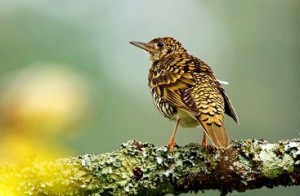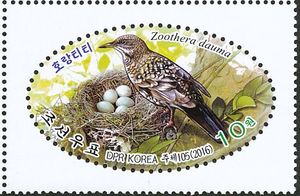Week 26 – 08 January 2017:
A Celebration of Good News
In 1908, a writer named Minori Ogawa published an article in the scholarly journal Annotationes Zoologicae Japonenses. The paper described birds from the southern islands of Japan. It seems that a Mr. Alan Owston of Yokohama had employed two men to shoot birds to add to his burgeoning collection of stuffed specimens. Between May and December of 1904 the collectors gathered specimens of 124 bird species.
According to Ogawa’s article, the collection included a thrush previously unknown to science. Ogawa described the Amami Thrush as being similar to White’s Thrush, but with twelve tail feathers instead of fourteen, and with a thicker, longer and darker bill. Ten specimens of this thrush were added to Owston’s collection. The bird was, and still is, known only from a single island, Amami-Oshima.
Leap forward a century…
The Amami Thrush, now considered to be a subspecies of the Eurasian Scaly Thrush, was doing very poorly. In 1996 the estimate of its abundance was just 58 individuals. Found on just a single island, the habitat favored by the Amami Thrush, old-growth broad-leafed forests, had been subject to clear-cut harvest between the late 1950s and 1970s. Far fewer trees meant far fewer thrushes.
And if that weren’t bad enough, thirty small Indian mongoose had been released on Amami-Oshima in 1979 in hopes that they would control populations of a venomous snake. In twenty years, the mongoose population grew from thirty to over 6,000 individuals. If you were a hungry mongoose, would you rather tackle a deadly venomous pit viper or a harmless little thrush?
Now comes the good news, courtesy of a recently published paper by Taku Mizuta and his colleagues. As a result of an eradication program that began in the year 2000, the population of mongooses has been significantly reduced. When contacted, Mizuta explained to me that it was likely that the last mongooses would be eliminated from Amami-Oshima by 2023. The large-scale clearance of mature forests on the island has declined since the 1970s, and it appears that habitat suitable for Amami Thrushes may be recovering. Have the birds responded to the change in circumstance?
Among the difficulties of assessing the abundance of these forest-dwelling thrushes is their timidity. It is simply a hard bird to spot. Fortunately, male Amami Thrushes have a loud, distinctive and melodious voice. Dedicated members of the Amami Ornithologists’ Club have, year after year, been engaged in formal censuses of their thrush. Starting before sunrise, they have been walking transect lines, listening for the thrush’s song, and plotting their observations on maps. In other areas, club members stood in particular spots for 50 minutes, documenting all of the Amami Thrushes heard.
Mizuta and his colleagues described the results of these surveys. They worked from the reasonable assumption that only adult male Amami Thrushes sing, and that females and immature males do not. They concluded that the thrush population has now climbed to about 5,000 males and females capable of breeding. Formally thought to be critically-endangered, as a result of the efforts of members of the Amami Ornithologist’s Club we can now say that the population is at least stable or may still be increasing.
Mizuta et al. wrote: “We intend to continue this public-participation survey for many years as a means of promoting further conservation of the Amami Thrush.” Has awareness of the plight of the bird increased? Mizuta wrote to me to say that the local newspaper and radio station have been reporting the results of the surveys each year, allowing locals to better identify with the birds. The social situation also seems to be changing for the better. The Japanese government is applying to have the Amami and Ryukyu islands added to UNESCOs list of World Heritage sites, and locals are showing more interest in the natural history of their part of the world.
All of that seems to be worth celebrating.
Mizuta, T., et al. 2016. Song-count surveys and population estimates reveal the recovery of the endangered Amami Thrush Zoothera dauma major, which is endemic to Amami-Oshima Island in south-western Japan.
Photo credits: Scaly thrush - zipcodezoo.com/index.php/Zoothera_dauma; Scaly thrush stamp – colnect.net



